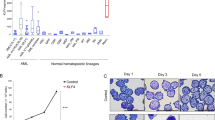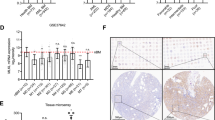Abstract
ML-1 human myeloblastic leukemia cells, suspended in serum-depleted medium, proliferate when the insulin-like growth factor-1 (IGF-1) and transferrin (Tf) are supplied, but differentiate to monocytes when these factors are replaced by the tumor necrosis factor-α (TNF-α). Induction of differentiation, but not of proliferation, involved the selective activation of diverse members of the NF-κB family of proteins. In differentiation-induced cells, NF-κB (p65) was translocated from the cytoplasm to the nucleus, whereas NF-κB (p75) remained localized to the cytoplasm. In contrast, NF-κB (p52) was present in the nuclei of proliferation- as well as of differentiation-induced ML-1 cells. The differentiation-specific translocation of NF-κB (p65) from the cytoplasm to the nucleus was mediated by an increase in the level of NIK, the NF-κB-inducing kinase which, through phosphorylation of IκB kinase α (Iκkα), causes a decrease in the level of IκBα, allowing p65 to move from the cytoplasm to the nucleus. The p52/p65 heterodimer formed in the nucleus, bound specifically to the promoter of the tumor suppressor protein p53, effecting a 25 to 30-fold increase in the level of this protein. As we reported previously (Li et al, Cancer Res 1998; 58: 4282–4287), that increase led to the decreased expression of proliferating cell nuclear antigen (PCNA) and to the loss of proliferation-associated DNA synthesis. The ensuing uncoupling of growth from differentiation was followed by the initiation of the monocyte-specific differentiation program.
This is a preview of subscription content, access via your institution
Access options
Subscribe to this journal
Receive 12 print issues and online access
$259.00 per year
only $21.58 per issue
Buy this article
- Purchase on Springer Link
- Instant access to full article PDF
Prices may be subject to local taxes which are calculated during checkout


Similar content being viewed by others
References
Liou HC, Baltimore D . Regulation of the NF-kappa B/Rel transcription factor and I kappa B inhibitor system Curr Opin Cell Biol 1993 5: 477–487
Baldwin AS Jr . The NF-kappa B and Ikappa B proteins: new discoveries and insights Annu Rev Immunol 1996 14: 649–683
May MJ, Ghosh S . Rel/NF-kappa B and IkappaB proteins: an overview Semin Cancer Biol 1997 8: 63–73
Muller JM, Rupec RA, Baeuerle PA . Study of gene regulation by NF-κB and AP-1 in response to reactive oxygen intermediates Methods 1997 11: 301–312
Siebenlist U . NF-κB/IκB proteins. Their role in cell growth, differentiation and development Biochim Biophys Acta 1997 1332: R7–R13
Albrecht H, Tschopp J, Jongeneel CV . Bcl-2 protects from oxidative damage and apoptotic cell death without interfering with activation of NF-κB by TNF FEBS Lett 1994 351: 45–48
Kabrun N, Enrietto PJ . The Rel family of proteins in oncogenesis and differentiation Semin Cancer Biol 1994 5: 103–112
Inuzuka M, Ishikawa H, Kumar S, Gelinas C, Ito Y . The viral and cellular Rel oncoproteins induce the differentiation of p19 embryonal carcinoma cells Oncogene 1994 9: 133–140
Perona R, Montaner S, Saniger L, Sanchez-Perez I, Bravo R, Lacal JC . Activation of the nuclear factor-κB by Rho, CDC-42 and Rac-1 proteins Genes Dev 1997 11: 403–475
Sokoloski JA, Sartorelli AC, Rosen CA, Narayanan R . Antisense oligonucleotides to the p65 subunit of NF-κB block CD11b expression and alter adhesion properties of differentiated HL-60 granulocytes Blood 1993 82: 625–632
Dokter WH, Tuyt L, Sierdsema SJ, Esselink MT, Vellenga E . The spontaneous expression of interleukine-1B and interleukin-6 is associated with spontaneous expression of AP-1 and NF-κB transcription factors in acute myeloblastic leukemia cells Leukemia 1995 9: 425–432
Conti L, Hiscott J, Papacchini M, Roulston A, Wainberg MA, Belardell F, Gessani S . Induction of Rel A (p65) and I kappa B alpha subunit expression during differentiation of human peripheral blood monocytes to macrophages Cell Growth Differ 1997 8: 435–442
Satriano J, Schlondorff D . Activation and attenuation of transcription factor NF-κB in mouse glomerular mesangial cells in response to tumor necrosis factor–alpha, immunoglobulin G, and adenosine 3′:5′ cyclic monophosphate. Evidence for involvement of reactive oxygen species J Clin Invest 1994 94: 1629–1636
Olashaw NE, Kowalik TF, Huang ES, Pledger WJ . Induction of NF-kappa B-like activity by platelet-derived growth factor in mouse fibroblasts Mol Biol Cell 1992 3: 1131–1139
Perkins ND, Schmid RM, Duckett CS, Leung K, Rice NR, Nabel GJ . Distinct combinations of NF-κB subunits determine the specificity of transcriptional activation Proc Natl Acad Sci USA 1992 89: 1529–1533
Beauparlant P, Hiscott J . Biological and biochemical inhibitors of the NF-kappaB/Rel proteins and cytokine synthesis Cytokine Growth Factor Rev 1996 7: 175–190
Kaufman PA, Weinberg JB, Greene WC . Nuclear expression of the 50 and 65 KD Rel-related subunits of nuclear factor-kappa B is differentially regulated in human monocytic cells J Clin Invest 1992 90: 121–129
Whiteside ST, Epinat JC, Rice NR, Israel A . I Kappa B epsilon, a novel member of the IkappaB family, control, RelA and c-Rel NF-kappaB activity EMBO J 1997 16: 1413–1426
Henkel, TJ, Machleidt TA, Alkalay I, Kronke M, Ben-Neriah Y, Baeuerle PA . Rapid proteolysis of IκBα is necessary for activation of transcription factor NF-κB. Nature (Lond) 1993 365: 182–185
DiDonato JA, Mercurio F, Karin M . Phosphorylation of I kappa B alpha precedes but is not sufficient for its dissociation from NF-kappaB Mol Cell Biol 1995 15: 1302–1311
Thompson JE, Phillips RJ, Erdjument-Bromage EH, Tempst P, Ghosh S . IκBα regulates the persistent response in a biphasic activation of NF-kappaB Cell 1995 80: 573–582
Liou HC, Sha WC, Scott ML, Baltimore D . Sequential induction of NF-Kappa B/Rel family proteins during B-cell terminal differentiation Mol Cell Biol 1994 14: 5349–5359
Baeuerle PA, Baltimore D . IκB: a specific inhibitor of the NF-κB transcription factor Science 1988 242: 540–546
Beg AA, Baldwin AS . The κB proteins. multifuctional regulators of Rel/NF-κB transcription factors Genes Dev 1993 7: 2064–2070
Venkataraman L, Wang W, Sen R . Differential regulation of c-Rel translocation in activated B and T cells J Immunol 1996 157: 1149–1155
Browning DD, Pan ZK, Prossnitz ER, Ye RD . Cell type and developmental stage-specific activation of NF-Kappa B by F-Met-Leu-Phe in myeloid cells J Biol Chem 1997 272: 7995–8001
Lewin SR, Lambert P, Deacon NJ, Mills J, Crowe SM . Constitutive expression of p50 homodimer in freshly isolated human monocytes decreases with in vitro and in vivo differentiation: a possible mechanism influencing human immunodeficiency virus replication in monocytes and mature macrophages J Virol 1997 71: 2114–2119
Wu H, Lozano G . NF-κB activation of p53 J Biol Chem 1994 269: 20067–20074
Li Z-R, Hromchak R, Mudipalli A, Bloch A . Tumor suppressor proteins as regulators of cell differentiation Cancer Res 1998 58: 4282–4287
Li Z-R, Hromchak R, Bloch A . Differential expression of proteins regulating cell cycle progression in growth vs differentiation Biochim Biophys Acta 1997 1356: 149–159
Ishikura H, Hori K, Bloch A . Differential biological effects resulting from bimodal binding of recombinant human tumor necrosis factor to myeloid leukemia cells Blood 1989 73: 419–424
Sakagami H, Ozer H, Minowada J, Takeda K, Bloch A . Differentiation-associated changes in human non-T, non-B leukemia cell lines after treatment with 12-O-teradecanoylphorbol 13-acetate Leukemia Res 1984 8: 187–195
Fujii Y, Takuma T, Bloch A . A regulatory role for tumor necrosis factor (TNF) in ML-1 human myeloblastic leukemia cell maturation Leukemia Res 1990 14: 941–947
Stancovski I, Baltimore D . NF-κB activation: the IκB kinase revealed? Cell 1997 91: 299–302
Shaulsky G, Goldfinger N, Peled A, Rotter V . Involvement of wild type p53 in pre-B-cell differentiation in vitro Proc Natl Acad Sci USA 1991 88: 8982–8986
Kastan MB, Radin AI, Kuerbitz SJ, Onyekwere O, Wolkow CA, Civin CI, Stone KD, Woo T, Ravindranath Y, Craig RW . Levels of p53 protein increase with maturation in human hematopoietic cells Cancer Res 1991 51: 4279–4286
Feinstein E, Gale RP, Reed J, Canaani E . Expression of the normal p53 gene induces differentiation of K562 cells Oncogene 1992 7: 1853–1857
Banerjee D, Lenz HJ, Schnieders B, Manno DJ, Ju JF, Spears CP, Hochhauser D, Danenberg K, Danenberg P, Bertino JR . Cell Growth Differ 1995 6: 1405–1413
Ehinger M, Nilsson E, Persson A-M, Olsson I, Gullberg U . Involvement of the tumor suppressor gene p53 in tumor necrosis factor-induced differentiation of the leukemic cell line K562 Cell Growth Differ 1995 6: 9–17
Ehinger M, Bergh G, Olofsson T, Baldetorp B, Olsson I, Gullberg, U . Expression of the p53 tumor suppressor gene induces differentiation and promotes induction of differentiation by 1,25-dihydroxycholecalciferol in leukemic U-937 cells Blood 1996 87: 1064–1074
Soddu S, Blandino G, Citro G, Scardigli R, Piaggio G, Ferber A, Calabretta B, Scacchi A . Wild-type p53 gene expression induces granulocytic differentiation of HL-60 cells Blood 1994 83: 2230–2237
Acknowledgements
This study was aided by grant CA-36241 from the National Cancer Institute, DHHS, and by a grant from the Roswell Park Alliance Foundation. We are grateful to Asahi Chemical Co., Tokyo, Japan for supplying TNFα. We also thank Dr Guillermina Lozano of the MD Anderson Cancer Institute, Houston,TX for providing the p53 CAT construct.
Author information
Authors and Affiliations
Rights and permissions
About this article
Cite this article
Mudipalli, A., Li, Z., Hromchak, R. et al. NF-κB (p65/RelA) as a regulator of TNFα-mediated ML-1 cell differentiation. Leukemia 15, 808–813 (2001). https://doi.org/10.1038/sj.leu.2402083
Received:
Accepted:
Published:
Issue Date:
DOI: https://doi.org/10.1038/sj.leu.2402083
Keywords
This article is cited by
-
Aspirin triggers ferroptosis in hepatocellular carcinoma cells through restricting NF-κB p65-activated SLC7A11 transcription
Acta Pharmacologica Sinica (2023)
-
Oridonin stabilizes retinoic acid receptor alpha through ROS-activated NF-κB signaling
BMC Cancer (2015)



